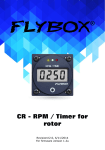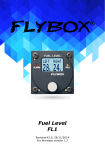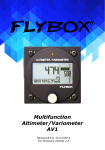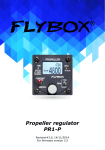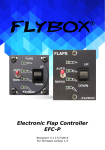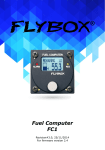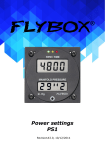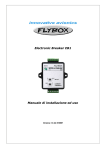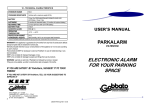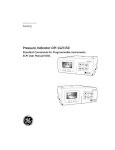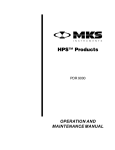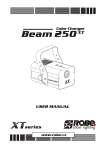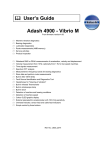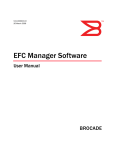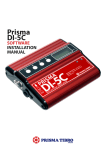Download Electronic Flap Controller EFC-P Installation and User manual
Transcript
Electronic Flap Controller EFC-P Installation and User manual Revision# 2.9 7/6/2011 For firmware version 1.4 1 Contents 1 Installation 1.1 Important notices and warnings ............................................................................ 1.2 Panel installation & dimensions (rectangular panel version) ................................ 1.3 Panel installation & dimensions (2 1/4” round panel version) .............................. 1.4 Important mechanical installation issues .............................................................. 1.4.1 Transducer issues .............................................................................................. 1.4.2 Actuator issues .................................................................................................. 1.5 Electrical installation ............................................................................................ 1.5.1 Wiring diagram for actuator with no internal limit switches ............................... 1.5.2 Wiring diagram for actuator with internal limit switches .................................... 1.5.3 Wiring diagram for actuator with internal limit switches and external wires ...... 1.5.4 Wirings check .................................................................................................... Page 2 3 3 4 4 4 5 5 5 6 6 2 Operation instructions 2.1 Panel indicators and commands ............................................................................ 2.2 Operation instructions ........................................................................................... 2.2.1 Use in AUTOMATIC mode ....................................................................... 2.2.2 Use in MANUAL mode ............................................................................. 2.3 Troubleshooting and error code of the EFC-P ....................................................... 6 7 7 7 8 3. Technical specifications ......................................................................................... 4. Warranty ................................................................................................................ 8 8 2 Installation 1.1 Important notices and warnings Although the EFC-P has been heavily tested to ensure the maximum safety in every condition, the correct operation depends also by installation and wiring, that must be accurately made and verified reading completely this manual. - Use aeronautic cable for the wiring and shielded cable for the position's transducer wiring. - The cable shielding is more effective if both termination are connected to GND. - The EFC-P cables (especially the position's transducer cables) must not run near cables and power devices that could generate noise, for example: transponder, transceiver, strobo light, inductive load such as electric motors, electric pumps and solenoids. - When the cabling is finished you must do a test, prior to flight, turning on all the possible source of electric noise and verifying the properly operating of the EFC-P. - The pilot must understand the operation of this device prior to flight, and must not allow anyone to use it without knowing the operation. - Keep this manual in the aircraft. WARNING: - The EFC-P is attached directly to the flaps actuator: the non-respect of the notices above or a damage to the EFC-P may result in unexpected movements of the flaps. In this situation you must immediately disable the EFC-P by turning the switch in the “MANUAL” position (see par.2.2.2 “Use in MANUAL mode”). - THE EFC-P MUST BE TURNED OFF IN CASE OF START WITH BOOSTER. OPEN THE CORRESPONDING BREAKER BEFORE STARTING. WARRANTY SHALL NOT APPLY FOR DAMAGE TO THE EFC-P FOR THIS REASON. If you do not agree with the notices above do not install the EFC-P in your aircraft, but return the product for a full refund. Microel s.r.l. reserves the right to change or improve its products. Information in this document is subject to change without notice. 3 1.2 Panel installation & dimensions (rectangular panel version) Panel cut-out 1.3 Panel installation & dimensions (2 1/4” panel version) 4 1.4 Important mechanical installation issues 1.4.1 Transducer issues (only if using actuator without integrated transducer) The installation consists in the mechanical coupling between the flaps actuator (motor) and the transducer (potentiometer) which permits the EFC-P to know the actual flaps position. In the following figures is showed the most common examples of mechanical coupling; the EFC-P is anyway adaptable to other mechanical installation. Example of mechanical installations - The transducer's travel must be at least 10mm more then the actuator's travel. - The electrical resistance of the transducer must be from 1 to 10 Kohm. - The transducer must be centered over the actuator's travel so that it isn't possible to exit from the limits, with consequently damage to the position's transducer. 1.4.2 Actuator issues - If the actuator doesn't have any internal limit switches it's necessary to install them externally. - To avoid the possibility of mechanical and electrical damage, the actuator travel must match exactly with the flaps travel: with the actuator completely retracted (limit switch reached) the flaps must be completely retracted (or completely extracted for inverse mechanical coupling); with the actuator completely extracted the flaps must be completely extracted (or completely retracted for inverse mechanical coupling). Adjust your actuator travel if it does not coincide with the flaps travel, for example using an arm/lever with an appropriate length. Correct installation: actuator travel exactly match flaps travel. - If the condition above indicated is not satisfied the actuator is not protected against possible overtravel during flap extension and retraction, therefore a pilot that drive the flaps manually (for example using “Manual” mode of the EFC-P) can cause mechanical damage if he don't stop exactly when the flaps have reached the up and down positions. 5 IMPORTANT NOTES ON USING ACTUATORS WITH INTEGRATED TRANSDUCER: - The electrical resistance of the transducer must be from 1 to 10 Kohm. - Choose a model that use the maximum electrical resistance range. For example if you choose an actuator with 10 Kohm transducer, verify that the stroke that you are going to use provide at least a variation of half the transducer's resistance, i.e. 5 Kohm. 1.5 Electrical installation In the backpanel there is a 10-poles plug connector (model: MOLEX Mini-Fit JR.); the corresponding socket connector is delivered with your EFC-P. The connections are: Socket view (from wire'insertion side) Backpanel plug 1 – Motor out (-) 2 – Power input (+12V) 3 - Positive voltage (+5V) for the position's transducer 4 – Position's transducer signal 5 – Ground for the position's transducer 6 – Motor out (+) 7 – Power input (GND) 8 – “DOWN” limit switch 9 – Limit switches common connection 10 – “UP” limit switch 1.5.1 Wiring diagram for actuator with no internal limit switches If the actuator used has no internal limit switches you must install them externally and follow the wiring diagram below. The UP and DOWN switches must be normally closed; diodes max current must be at least 3 Ampere. Pay attention to the UP and DOWN limit switches mechanical and electrical installation, because a wrong connection can prevent the EFC-P from turn off the actuator before the mechanical stop, with possible damage to the actuator itself. 1.5.2 Wiring diagram for actuator with internal limit switches If the actuator used has integrated limit switches and wiring (no external wires) use the wiring diagram above, connecting pin #1 and #6 of the EFC-P connector directly to the actuator. 6 1.5.3 Wiring diagram for actuator with internal limit switches and external wires If the actuator used has 3 wires for the limit switches connection, probably one wire is the common contact for the limit switches, so the wiring diagram to the EFC-P is the following: 1.5.4 Wirings check 1- When finished all the wirings turn the Auto/Manual switch in Manual position and check the flaps movement with the UP/DOWN switch: press in “DOWN” position and check that the flaps go down, press in “UP” position and check that the flaps go up. If directions are reversed swap the two actuators wire (pin 1 and 6 on the EFC-P connector). 2- The wiring between the transducer and the EFC-P connector (pins 3-5) depends on the actuator-transducer mechanical coupling (i.e. flaps down-->transducer's shaft extracted or flaps down-->transducer's shaft retracted). To check if the wirings are ok measure the voltage between ground (pin#7) and pin #4 of the EFC-P connector: with the flaps completely down the voltage must be to its maximum value, with the flaps completely up the voltage must be to its minimum. If this doesn't occur, or if the EFC-P does not work correctly, swap the two wires on pins #3 and #5 of the EFC-P connector. Operation instructions 2.1 Panel indicators and commands LED1 LED2 A/M switch (Auto/Manual) U/D switch (Up/Down) LED3 LED4 The Auto/Manual switch has a safety lock to avoid accidental operation: it must first pulled on the outside and then moved to the desired position. 7 2.2 Operation instructions The EFC-P can work in two modes: Automatic or Manual. For normal operations use the “Automatic” mode; the “Manual” mode must be used only in case of emergency or failure of the EFC-P. Before using the device for the first time you must program the four position that the EFC-P store in memory and use in Automatic mode: - With the device powered off turn the A/M switch in the “Automatic” position, then press and hold the U/D switch in the “UP” position. - Power on the EFC-P and wait 10 seconds until the LED1 and the LED4 start flashing. - Release the U/D switch. NOTE: The EFC-P doesn't enter in the programming mode if a limit switch is open (UP or DOWN limit switch); if this occour you must turn in “Manual” mode and move the flaps until the limit switch will de-activate. - Make this sequence using the U/D switch: 2 click in the UP position, 2 click in the DOWN position and 1 click in UP; if the sequence is correct the EFC-P enter in programming mode and the LED2/LED3 briefly flash. The EFC-P will automatically exit from the programming mode if no press is made on the U/D switch for 10 seconds. - Now the first led is flashing indicating that you can adjust the flaps in the desired position (using the U/D switch). To store the position, briefly move the A/M switch in “Manual” and then return in “Automatic”. - Now the second led is flashing and you can adjust and then store the second position in the same way explained in the previous step (U/D switch to adjust then A/M switch to store the position). Repeat again the step for the third and fourth position. The EFC-P will automatically exit from the programming mode and become operative once the last position is correctly stored in memory. The positions remains stored in memory also without power supply. NOTE: If the EFC-P is powered on the first time without enter in the programming mode the four LED will simultaneously flash. 2.2.1 Use in AUTOMATIC mode In AUTOMATIC mode you can move the flaps choosing one of the four stored position; the maximum travel of the motor is defined by the two limit switches UP and DOWN. The LEDs show the status of the flaps: LED on: indicate the current position of the flaps LED flashing: indicate the position that the flaps are reaching -EXAMPLE OF USEThe flaps are in the first position (LED1 on, all other LEDs off): to move the flaps in the third position press two times the U/D switch in the DOWN position; the flaps start moving and the third LED is flashing, indicating the position that the flaps are reaching. When the flaps reaches the second position the first LED turn off while the second turn on; when they reaches the third position the second LED turn off and the third turn on. The flaps have reached the selected position and the EFC-P return to steady state, waiting for another command. Pressing the U/D switch in the UP position for more than 1 second move automatically the flaps to the first position (regardless of the current position). 2.2.2 Use in MANUAL mode In this mode the flaps position are not fixed between the four programmed positions but the movement are continuous; however it's recommended to use the MANUAL mode only in case of device's electronic failure, because this mode bypass the internal electronic circuits and connect directly the motor to the U/D switch. To control the flaps simply use the U/D switch: press and hold in a position (UP or DOWN) and release when the motor have reached the desired position. 8 2.3 Troubleshooting and error code of the EFC-P All the four LEDs flashing: no positions' programming have been made (see paragraph 2.2). LED1 and LED2 flashing: it means that the EFC-P try to move the motor but there is no feedback from the transducer: can be a wrong connections on the motor's wiring or on the transducer's wiring. To exit from this condition you must turn off the device and remove the cause of failure. LED1 and LED3 flashing: it means that the connection motor/transducer are not correct; maybe the motor's wire reversal or a wrong tranducer wiring. To exit from this condition you must turn off the device and remove the cause of failure. LED2 and LED4 flashing: it means that the EFC-P has detected an over-current condition. Check that wirings of the actuator motor have no short circuits or check that the actuator is working correctly. 3. Technical specifications Frontpanel dimensions: 61.8 x 71.8 mm (rectangular panel version) 60.0 x 60.0 mm (2 1/4” round panel version) Depth: 46 mm (rectangular panel version) 52 mm (2 1/4” round panel version) Weight: 125 g Power requirements: 12 ~ 20 V= / 80 mA Maximum current supplied to the motor: 7 Ampere Operating temperature range: -20 ~ +70 °C Relative humidity: 10% ~ 90% 4. Warranty This product is warranted to be free from defects for a period of 12 months from the user invoice date. The warranty only cover the manufacture's defects; shall not apply to product that has been improper installed, misused or incorrect maintenance, repaired or altered by non-qualified person. MICROEL s.r.l. Via Mortara 192-194 27038 Robbio(PV) - ITALY Tel +39-0384-670602 - Fax +39-0384-671830 www.flyboxavionics.it WARNING: All photos, data, drawings, instruments layouts, technical solutions and data representation you find in this document or watching at FLYBOX instruments working and/or you can access by means of any other media, including web sites, are sole property of MICROEL SRL, cannot be copied or imitate without a written permission of MICROEL SRL itself and are protected by law, even by means of extended international copyright and/or specific patents deposited. Any infringement of this statement and of MICROEL SRL intellectual property will be prosecuted. ©2011 Microel s.r.l. – all rights reserved. 9









